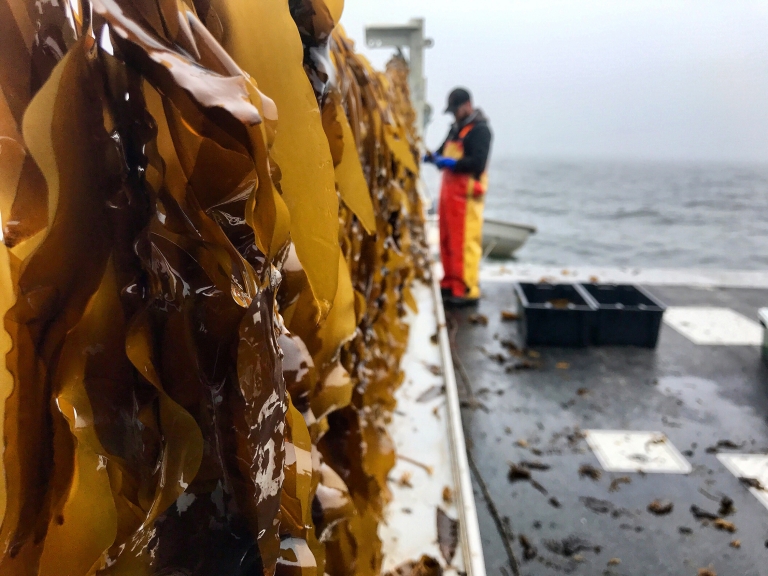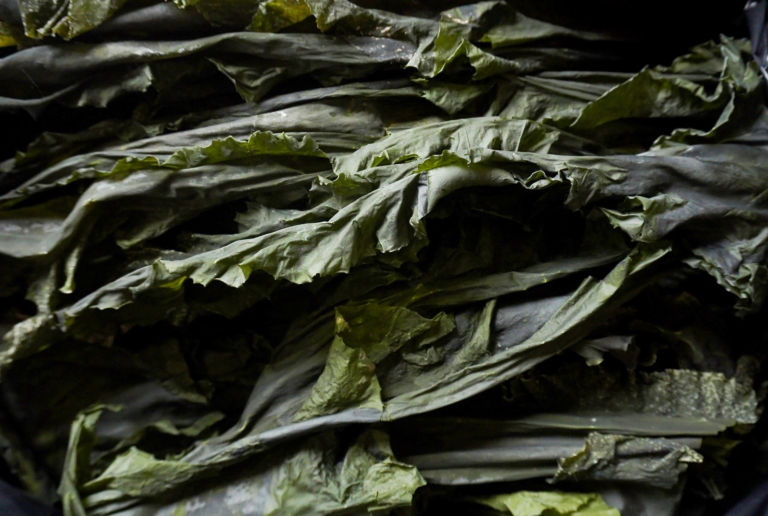The Nautical Farmers
All photos courtesy of Morgan-Lea Fogg
In 2016, shortly after moving on a whim to Denver, Colorado, from their home state of Maine, Morgan-Lea Fogg and her fiancé Jake Patryn got really excited about kelp. Through her work as a social media community manager at Summit, an organization that connects the next generation of leaders and global thinkers, Morgan was introduced to the concept of kelp farming and kelp-based foods and its potential to help stop climate change. She was hooked. She devoured everything she could about conservation and environmentalism, including Dr. Richard Oppenlander’s Comfortably Unaware, a book that details the impact of our food choices on the environment.

Morgan-Lea Fogg, Co-Founder of Nautical Farms holding up long blades of Sugar Kelp recently grown on their farm in Maine.
She learned that kelp is naturally nutritious and full of vitamins and minerals, and that it can be dried, turned into noodles, made into seasoning flakes, pickled or smoked. Beyond food, seaweed can be used to make bioplastics, as a natural fertilizer for land-based agriculture and as an ingredient in cosmetics and skin care; it also has potential as a scalable biofuel source, among other applications. It grows easily and prolifically in the ocean without any additional inputs, such as fresh water or fertilizer. And kelp, the largest subgroup of seaweed, is a world-class photosynthesizer. It uses the sun to turn carbon dioxide and water into energy and is shown to be very effective at carbon sequestration. While there’s still plenty to learn about the role seaweed farming can play in climate change mitigation, research so far has shown that no-harvest seaweed farms can serve to offset regional CO2 emissions, and early studies around sustainably growing and harvesting seaweed as part of a larger permaculture operation are yielding promising results.
Morgan spent the next year learning everything she could about kelp farming: reading books, talking to the relatively small group of existing kelp farmers and looking into markets for the farmed product. “I go all in when something catches my interest,” she says. It turns out that her hometown in coastal Maine is a perfect location to grow seaweed. “I tried to convince friends back home to start a seaweed farm, but no one bit,” says Morgan. There was only one option: “We decided to move back to Maine and do it ourselves.”
While kelp farming at scale is a new thing along Maine’s craggy “down east” coastline, traditional Indigenous seaweed gathering is not. For thousands of years, the Wabanaki people, including the Mi’kmaq, Maliseet, Passamaquoddy, Penobscot and Abenaki Nations, have harvested kelp for its nutritional value, using it for seasoning, snacks and as part of traditional clambakes.
While seaweed farming has been around for centuries—there’s evidence of its cultivation in Japan all the way back to the 1600s—the industry has remained small and growing kelp commercially is still fairly uncharted territory. There’s not yet much of a market for seaweed in the United States, so there’s less perceived value to farming it at scale. That’s beginning to change. In 2018 (the most recent market report available), the Food and Agriculture Organization of the United Nations named seaweed farming the fastest growing sector in aquaculture. And kelp farms are becoming more common along the East Coast from Maine (where some estimates put the number of active sites at more than 200) down to Long Island, New York, as well as along the West Coast.

Co-Founder of Nautical Farms, Jake Patryn, trimming and harvesting the sugar kelp crop which will be sent to shore via boat to be sun dried and made into a variety of nutritious products.
In January 2017, the couple packed their bags and headed back East to their hometown of Machias, Maine.
“I was so happy they were coming home, but I didn’t know anything about what they were going to do,” says Lisa Fogg, Morgan’s mom. “Morgan has always been one to take risks. She’s very calculated, and she gives her decisions a lot of thought. She and Jake understood what they were getting into—they had a real plan for something I’d never even heard of!”
Jake’s family had a similar reaction. Although his grandpa, dad, uncles and brother are all lobstermen, and Jake is licensed and still helps out in the summers, kelp farming was new to them. In other words, seaweed farming wasn’t what everyone expected when they heard Jake and Morgan were coming home.
But the couple knew it made sense. Food-grade seaweed grows best in the winter, which is opposite lobster season. This diminishes concerns about taking valuable ocean-floor space away from local lobstermen during the summer, while also providing a potential income stream for those who want to work the kelp farms in the off-season.
For Jake, the potential to create jobs by introducing his neighbors to new ways of making a living on the ocean—while also taking care of it—was a big part of the allure. It helped that running a seaweed farm involved much of the same gear and skills as lobster fishing.
“We googled the heck out of everything we could, and we talked to some folks along the East Coast who’d been farming seaweed for a few years,” says Jake. Under the mentorship of more-seasoned growers, Jake spent the first half of the year building the seaweed farm, which essentially involves “renting” a plot of ocean: a field about 5 to 6 feet underwater, consisting of lengths of twine embedded with seaweed spores strung between two pieces of PVC pipe. In October 2017, Morgan and Jake seeded their first crop over 1 acre of ocean floor off the coast of Machiasport, and their company, Nautical Farms, was born.
“There was a lot of learning that first year,” says Jake. “We actually seeded the first half of that crop in October and the second half in November. The part that was seeded in November didn’t do as well, and we think it’s because the water and air were both too cold that day. We also suffered some ice damage and lost about 25 percent of the stuff that was growing really well. But the learning curve is part of the process.”

Sun dried North Atlantic Sugar Kelp grown and harvested on a farm off the coast of Maine.
Now in its fourth season, Nautical Farms has quadrupled the size of its operation to 4 acres. In the first three years, the operation focused solely on growing sugar kelp, a brown alga that’s rich in fiber, vitamin C, iron and calcium. The versatile crop has a variety of applications, including food and cosmetics. It’s also a prolific grower—yielding about 10 pounds of seaweed per foot of line. This season, the couple added a second variety to the mix: Alaria, another brown plant that’s high in bioavailable iron and iodine (commonly found in miso soup). Other options, like dulse, a red alga that tastes like bacon, are in consideration for the future. While the inaugural crop was sent to a third-party processor to be dried, blanched and frozen before being distributed to customers, Jake and Morgan now process their own harvest.
Nautical Farms sells their dried seaweed directly to customers—including, pre-pandemic, two James Beard Award-winning chefs and a few retail clients. They’ve also started venturing into the home space with bath soaks and candles.
One of Morgan and Jake’s most important goals is to help others enter the industry and start their own farms.
“Some of the older folks who’ve spent their lives lobster fishing, they’re aware that it might not be around for another generation, at least [not] the same way it is now,” says Jake. “They see what we’re doing as something they can teach their kids, as another way to make a living on the water. We want to help them.”
Jake spends a lot of time out in the community, teaching entrepreneurial courses to potential seaweed-farming enthusiasts and getting the word out at farmers markets and libraries.
“Machias is such a small town that for a lot of people here, there’s no reason to stay,” says Morgan. “Unless you work on the water or have a related trade job, there’s not a whole lot that this area offers. We want to show people there’s a reason to stay.”


